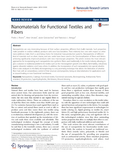Nanomaterials for functional textiles and fibers
Fecha
2015Autor
Versión
Acceso abierto / Sarbide irekia
Tipo
Artículo / Artikulua
Versión
Versión publicada / Argitaratu den bertsioa
Impacto
|
|
10.1186/s11671-015-1195-6
Resumen
Nanoparticles are very interesting because of their surface properties, different from bulk materials. Such properties
make possible to endow ordinary products with new functionalities. Their relatively low cost with respect to other
nano-additives make them a promising choice for industrial mass-production systems. Nanoparticles of different
kind of materials such as silver, titania, and zinc ...
[++]
Nanoparticles are very interesting because of their surface properties, different from bulk materials. Such properties
make possible to endow ordinary products with new functionalities. Their relatively low cost with respect to other
nano-additives make them a promising choice for industrial mass-production systems. Nanoparticles of different
kind of materials such as silver, titania, and zinc oxide have been used in the functionalization of fibers and fabrics
achieving significantly improved products with new macroscopic properties. This article reviews the most relevant
approaches for incorporating such nanoparticles into synthetic fibers used traditionally in the textile industry allowing to
give a solution to traditional problems for textiles such as the microorganism growth onto fibers, flammability, robustness
against ultraviolet radiation, and many others. In addition, the incorporation of such nanoparticles into special ultrathin
fibers is also analyzed. In this field, electrospinning is a very promising technique that allows the fabrication of ultrathin
fiber mats with an extraordinary control of their structure and properties, being an ideal alternative for applications such
as wound healing or even functional membranes. [--]
Materias
Nanoparticles,
Coatings,
Functional textiles,
Functional nanowebs,
Electrospinning,
Antibacterial,
Flame retardant,
UV-protection,
Superhydrophobic,
Membranes,
Wound dressing
Editor
Springer US
Publicado en
Nanoscale Research Letters (2015) 10:501
Departamento
Universidad Pública de Navarra. Departamento de Ingeniería Mecánica, Energética y de Materiales /
Nafarroako Unibertsitate Publikoa. Mekanika, Energetika eta Materialen Ingeniaritza Saila /
Universidad Pública de Navarra. Departamento de Ingeniería Eléctrica y Electrónica /
Nafarroako Unibertsitate Publikoa. Ingeniaritza Elektrikoa eta Elektronikoa Saila
Versión del editor
Entidades Financiadoras
This work was supported in part by the Spanish Ministry of Economy and
Competitiveness—CICYT-FEDER TEC2013-43679-R research grant, and an
UPNA pre-doctoral research grant.
Aparece en las colecciones
Los documentos de Academica-e están protegidos por derechos de autor con todos los derechos reservados, a no ser que se indique lo contrario.
La licencia del ítem se describe como © 2015 Rivero et al. Open Access This article is distributed under the terms of the Creative Commons Attribution 4.0 International License (http://creativecommons.org/licenses/by/4.0/), which permits unrestricted use, distribution, and reproduction in any medium, provided you give appropriate credit to the original author(s) and the source, provide a link to the Creative Commons license, and indicate if changes were made.







